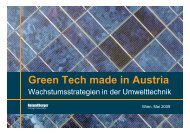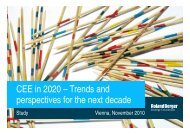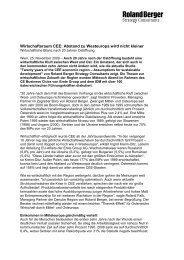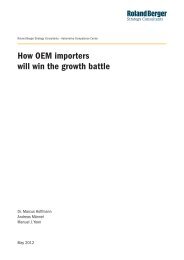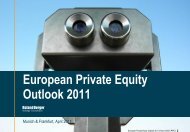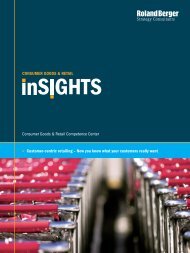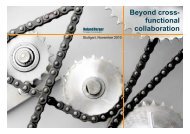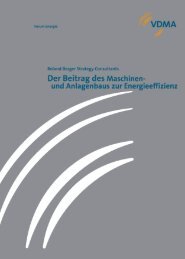The global aerostructures tooling equipment market
The global aerostructures tooling equipment market
The global aerostructures tooling equipment market
Create successful ePaper yourself
Turn your PDF publications into a flip-book with our unique Google optimized e-Paper software.
<strong>The</strong> <strong>global</strong> <strong>aerostructures</strong><br />
<strong>tooling</strong> <strong>equipment</strong> <strong>market</strong><br />
Study summary<br />
Munich, March 2012<br />
Areostructures_Tooling_Equipment_FINAL_short.pptx<br />
1
WHAT IS THE STUDY ABOUT?<br />
Executive summary<br />
> Roland Berger conducted a study about the <strong>global</strong> <strong>aerostructures</strong> <strong>tooling</strong> <strong>equipment</strong> <strong>market</strong> based on<br />
extensive desk research and expert interviews as well as bottom-up <strong>market</strong> modeling along the value chain<br />
> In 2012, relevant <strong>market</strong> expected to reach all-time peak of USD 1.4 bn stimulated by A350 and B787 programs<br />
> However, in 2020, <strong>market</strong> downturn by 75% to USD ~400 m expected due to lack of new programs<br />
> Consequently, installed capacity exceeds demand – Shift towards optimization/retrofit of existing <strong>equipment</strong><br />
> Service <strong>market</strong> share in 2020 of ~60% indicates need for full service offers, e.g. consulting or process optimization<br />
> In addition, demand for simplified products and turnkey solutions at lower costs from emerging <strong>market</strong>s<br />
combined with upcoming local suppliers drive trend towards cost efficient standardization and modularization<br />
> Overall, <strong>aerostructures</strong> <strong>tooling</strong> <strong>equipment</strong> industry expected to undergo industrialization – Reflected by<br />
automated processes, flexible production systems or other learnings from already industrialized industries<br />
> Roland Berger expects that only two business models ensure a sustainable business<br />
– Turn-key provider – Service-driven business model capitalizing on need for comprehensive turn-key solutions<br />
– System optimizer – Focusing on in-depth know-how of single systems to optimize existing <strong>equipment</strong><br />
> Roland Berger experts have a proven track record in the <strong>aerostructures</strong> <strong>tooling</strong> <strong>equipment</strong> <strong>market</strong> and are ready<br />
to support you in securing your success and preparing for the upcoming future challenges<br />
Source: Roland Berger<br />
Areostructures_Tooling_Equipment_FINAL_short.pptx<br />
2
Contents Page<br />
A. Research approach and <strong>market</strong> definition<br />
Market estimation derived from underlying end <strong>market</strong>s and expert interviews 4<br />
B. Market for <strong>aerostructures</strong> <strong>tooling</strong> <strong>equipment</strong><br />
Volume of USD 1.4 bn in 2012 falling to approx. USD 400 m in 2020 9<br />
C. Need for action and recommendations<br />
Shift in <strong>market</strong> and increase in volume and scope of services 21<br />
© Roland Berger Strategy Consultants<br />
Areostructures_Tooling_Equipment_FINAL_short.pptx<br />
3
A. Research approach and <strong>market</strong> definition<br />
Areostructures_Tooling_Equipment_FINAL_short.pptx<br />
4
A RESEARCH APPROACH AND MARKET DEFINITION<br />
Our study analyzes the highly dynamic <strong>tooling</strong> <strong>equipment</strong> <strong>market</strong> for<br />
the <strong>aerostructures</strong> industry<br />
Background, methodology and key findings<br />
Background Methodology<br />
KEY FINDINGS<br />
> OEM (civil and military) and<br />
<strong>aerostructures</strong> <strong>market</strong> has been<br />
characterized by an increased<br />
workshare and responsibility of<br />
suppliers and a shift to new<br />
<strong>market</strong>s as well as volatile<br />
demand in recent years<br />
> Tooling <strong>equipment</strong> <strong>market</strong> faces<br />
a broad range of challenges in<br />
line with increasing demand for<br />
industrialized process and<br />
process stability/reproducibility<br />
> Third RB <strong>tooling</strong> <strong>equipment</strong><br />
study analyzes this key <strong>market</strong>,<br />
major trends and success<br />
factors for the future<br />
Source: Roland Berger<br />
> Interviews along the entire<br />
value chain of aircraft production<br />
> Desk research and competitor<br />
benchmarks<br />
> Market model for <strong>tooling</strong><br />
<strong>equipment</strong> is based on a<br />
detailed modeling of underlying<br />
customer <strong>market</strong>s and expert<br />
interviews<br />
> Market forecast 2010-2020<br />
> Trends & developments in the<br />
<strong>tooling</strong> <strong>equipment</strong> <strong>market</strong><br />
> Strategic challenges and<br />
success factors for different<br />
business models<br />
> Key strategic recommendations<br />
to ensure future business<br />
success<br />
Areostructures_Tooling_Equipment_FINAL_short.pptx<br />
5
A RESEARCH APPROACH AND MARKET DEFINITION<br />
<strong>The</strong> <strong>global</strong> <strong>aerostructures</strong> <strong>tooling</strong> <strong>equipment</strong> <strong>market</strong> study covers<br />
nearly all leading industry players and expert sources<br />
DESK RESEARCH<br />
Source: Roland Berger<br />
Global <strong>aerostructures</strong> <strong>tooling</strong> <strong>equipment</strong> <strong>market</strong> study<br />
EQUIPMENT SUPPLIERS<br />
Global Aerostructures<br />
Tooling Equipment<br />
Market 2010-2020<br />
CUSTOMER INTERVIEWS<br />
INDUSTRY INTERVIEWS<br />
Areostructures_Tooling_Equipment_FINAL_short.pptx<br />
6
A RESEARCH APPROACH AND MARKET DEFINITION<br />
We followed a unique, detailed approach – Relevant <strong>market</strong> derived<br />
from underlying customer <strong>market</strong>s worldwide<br />
Study approach and results<br />
STUDY APPROACH<br />
Global civil and military<br />
aircraft <strong>market</strong><br />
Starting point is a forecast<br />
for the OEM <strong>market</strong> for<br />
civil and military aircraft<br />
and helicopters by model<br />
Source: Roland Berger<br />
Aerostructures<br />
<strong>market</strong><br />
Based on a detailed<br />
demand forecast, we<br />
derive the <strong>global</strong><br />
<strong>aerostructures</strong><br />
<strong>market</strong> of OEMs and<br />
Tier 1-3<br />
Tooling<br />
<strong>equipment</strong> <strong>market</strong><br />
Using our insights into<br />
customer <strong>market</strong>s, we<br />
then forecast the<br />
<strong>tooling</strong> <strong>equipment</strong><br />
<strong>market</strong> in detail<br />
Results<br />
> Market development (product<br />
offering, segments and regions)<br />
> Current and future customer<br />
requirements along value chain<br />
> Relationship between <strong>market</strong><br />
drivers for OEMs and the<br />
<strong>aerostructures</strong> and <strong>equipment</strong><br />
<strong>market</strong>s<br />
> Technology trends in aerospace<br />
industry and influence on<br />
<strong>equipment</strong> manufacturers<br />
> Current and future success<br />
factors for <strong>tooling</strong> <strong>equipment</strong><br />
manufacturers<br />
Areostructures_Tooling_Equipment_FINAL_short.pptx<br />
7
A RESEARCH APPROACH AND MARKET DEFINITION<br />
From a customer perspective, the <strong>aerostructures</strong> <strong>tooling</strong> <strong>equipment</strong><br />
<strong>market</strong> can be clustered into three main segments<br />
Market definition and scope of the study<br />
Segment<br />
I<br />
II<br />
II<br />
DRILLING &<br />
RIVETING<br />
POSITION-<br />
ING<br />
JIGS,<br />
HANDLING<br />
AND<br />
TRANSPORT<br />
SYSTEMS<br />
1) CFRP: carbon fiber reinforced plastics<br />
Source: Expert interviews, Roland Berger<br />
Scope of study: <strong>aerostructures</strong> <strong>tooling</strong> <strong>equipment</strong><br />
> Automated and semi-automated systems<br />
and <strong>equipment</strong> for drilling, riveting and<br />
welding components/modules<br />
> Major suppliers: Brötje Automation,<br />
ElectroImpact, Gemcor, Loxin 2002<br />
> Systems for high-precision movement and<br />
positioning of components and modules<br />
within the assembly process<br />
> Major suppliers: AIT, Brötje Automation,<br />
Dürr, ECA, MCE<br />
> Manual and automated systems for fixing,<br />
mounting, storage and transportation of<br />
components and modules<br />
> Major suppliers: virtually all OEMs,<br />
<strong>aerostructures</strong> and <strong>equipment</strong> suppliers<br />
Not in scope<br />
CFRP 1)<br />
manufacturing<br />
> Machines for<br />
manufacturing<br />
CFRP parts,<br />
mainly automated<br />
tape laying<br />
(ATL) and<br />
automated fiber<br />
placement (AFP)<br />
machines<br />
Areostructures_Tooling_Equipment_FINAL_short.pptx<br />
8
B. Market for <strong>aerostructures</strong> <strong>tooling</strong> <strong>equipment</strong><br />
Areostructures_Tooling_Equipment_FINAL_short.pptx<br />
9
B MARKET FOR AEROSTRUCTURES TOOLING EQUIPMENT<br />
Four drivers characterize automated <strong>tooling</strong> <strong>equipment</strong> <strong>market</strong> – New<br />
program launch, rate increases, cost pressure & new technology<br />
Major <strong>market</strong> drivers – overview<br />
Start of new programs<br />
> Launch of new programs requires development<br />
and installation of customized <strong>equipment</strong><br />
Rate increases in existing programs<br />
> Significant increases of cadence for existing<br />
models require higher automation and process<br />
industrialization and even add-on capacity<br />
Cost/efficiency pressure<br />
> Increase in productivity to reduce unit costs<br />
> Increase in process stability/reproducibility and<br />
reduction of supply chain risks<br />
New technology & materials<br />
> New, more efficient technology and materials<br />
drive adjustments/replacements of <strong>equipment</strong><br />
Source: Expert interviews, Roland Berger<br />
I<br />
PURCHASING NEW<br />
EQUIPMENT<br />
> Development and procurement of new, modelspecific<br />
systems and <strong>equipment</strong> for<br />
manufacturing and assembly<br />
> Investment often within a period of 2-4 years<br />
II<br />
INDUSTRIALIZATION<br />
> Upgrades/updates of <strong>equipment</strong> & systems<br />
> Partial or full automation of manual processes<br />
> Increase of process stability through<br />
automation, measuring and control technology<br />
III<br />
OPTIMIZATION OF EQUIPMENT<br />
> Process optimization based on existing <strong>equipment</strong> with<br />
minimal investment to increase output<br />
Volatile demand<br />
mainly driven by<br />
overall economic<br />
development<br />
Areostructures_Tooling_Equipment_FINAL_short.pptx<br />
10
B MARKET FOR AEROSTRUCTURES TOOLING EQUIPMENT<br />
In 2010, the <strong>tooling</strong> <strong>equipment</strong> <strong>market</strong> was worth USD 1.1 bn –<br />
Largest segment is positioning systems for final assembly<br />
Global <strong>aerostructures</strong> automated <strong>tooling</strong> <strong>equipment</strong> <strong>market</strong> 1) , 2010 [USD m]<br />
TOTAL VOLUME: USD 1,110<br />
Jigs,<br />
transport,<br />
logistics<br />
(total: 432)<br />
Positioning<br />
(total: 423)<br />
Riveting, drilling,<br />
robotics<br />
(total: 115)<br />
270<br />
127<br />
(47%)<br />
98<br />
(36%)<br />
45<br />
(17%)<br />
Sub-module<br />
assembly<br />
1) Excluding automated carbon fiber <strong>equipment</strong> (AFP, ATL)<br />
Source: Expert interviews, Roland Berger<br />
300<br />
125<br />
(42%)<br />
125<br />
(42%)<br />
50<br />
(17%)<br />
Module<br />
assembly<br />
400<br />
180<br />
(45%)<br />
200<br />
(50%)<br />
20<br />
(5%)<br />
Final assembly<br />
140<br />
Service<br />
COMMENTS<br />
> Jigs, transport, logistics and<br />
positioning systems are the largest<br />
segments, worth approx. USD 430 m<br />
in total in 2010<br />
> Riveting and drilling <strong>equipment</strong> have<br />
around a 10% <strong>market</strong> share – main<br />
application in sub-module (e.g.<br />
fuselage shells/hull) and module<br />
assembly (e.g. fuselage sections)<br />
> Within final assembly there is limited<br />
automated riveting and drilling<br />
<strong>equipment</strong> demand – large share of<br />
manual labor supported by jigs and<br />
positioning systems<br />
> Demand for jigs and handling<br />
systems grows with increasing<br />
component size<br />
Areostructures_Tooling_Equipment_FINAL_short.pptx<br />
11
B MARKET FOR AEROSTRUCTURES TOOLING EQUIPMENT<br />
Demand will remain at record levels in the short term – Significant<br />
downturn and shift to service expected from 2013 onwards<br />
Aerostructures <strong>tooling</strong> <strong>equipment</strong> <strong>market</strong>, 2006-2020e (illustrative) [USD m]<br />
781<br />
15%<br />
85%<br />
06<br />
904<br />
14%<br />
86%<br />
07<br />
Service<br />
1.119<br />
12%<br />
88%<br />
08<br />
+83%<br />
890<br />
16%<br />
84%<br />
09<br />
Equipment<br />
Note: USD:EUR exchange rate: 1.35<br />
1.110<br />
13%<br />
87%<br />
10<br />
Source: Expert interviews, Roland Berger<br />
1.290<br />
11%<br />
89%<br />
11e<br />
1.426<br />
10%<br />
90%<br />
12e<br />
1.202<br />
12%<br />
88%<br />
13e<br />
944<br />
17%<br />
83%<br />
14e<br />
789<br />
23%<br />
77%<br />
15e<br />
-73%<br />
636<br />
31%<br />
69%<br />
16e<br />
425<br />
52%<br />
48%<br />
17e<br />
As of today no<br />
new programs<br />
after 2016<br />
announced<br />
364<br />
63%<br />
37%<br />
18e<br />
380<br />
63%<br />
37%<br />
19e<br />
385<br />
62%<br />
38%<br />
20e<br />
COMMENTS<br />
> A350 (and last phase of B787 <strong>tooling</strong>)<br />
drive peaking <strong>market</strong> in 2011 and 2012<br />
> Start-up of new programs in China and<br />
Russia dampens the declining demand<br />
in medium term from 2013 onward<br />
> Slump after 2016 due to lack of new<br />
programs at that stage between EIS of<br />
A320 NEO/B737 MAX and end of the<br />
decade on LCA<br />
> Substantial shift towards optimization<br />
and retrofit of existing <strong>equipment</strong><br />
causes significantly reduced volume<br />
> Rate increases covered by optimization<br />
of existing systems with only low<br />
investments – significant rate increases<br />
realized by duplication of existing<br />
systems including minor adjustments/<br />
improvements<br />
Areostructures_Tooling_Equipment_FINAL_short.pptx<br />
12
B MARKET FOR AEROSTRUCTURES TOOLING EQUIPMENT<br />
<strong>The</strong> <strong>market</strong> is indirectly driven by growth in customer <strong>market</strong>s –<br />
Primary strategic and operational requirements identified<br />
Relationship of <strong>market</strong> drivers in OEM, <strong>aerostructures</strong> and <strong>tooling</strong> <strong>equipment</strong> <strong>market</strong><br />
OEM (aircraft<br />
manufacturing)<br />
> Growth of world economy<br />
> Growth of <strong>global</strong> trade<br />
> Liberalization of air space<br />
> Development of oil/kerosene price<br />
> Development of wages<br />
Strategic requirements<br />
> Consolidation and specialization<br />
of players<br />
> Internationalization and expansion<br />
of footprint for targeting new<br />
<strong>market</strong>s<br />
> Taking on development and<br />
financing risks<br />
Source: Expert interviews, Roland Berger<br />
Operational requirements<br />
> Handling of complete system/module responsibility<br />
> Industrialization of manufacturing and assembly<br />
process<br />
> Integration of new materials<br />
Aerostructures<br />
manufacturing<br />
> Global fleet growth<br />
> Governmental industrial policy<br />
> Cost and efficiency pressures<br />
> Risk reduction by OEMs<br />
Strategic requirements<br />
> Global turnkey capabilities for large projects<br />
> Acting as a problem-solving partner for the<br />
complete manufacturing and assembly process<br />
> Local engineering and after-sales expertise<br />
Operational requirements<br />
> Suitability for interdisciplinary<br />
<strong>global</strong> development partnerships<br />
> Greatest process stability and<br />
reproducibility<br />
> Flexible system design and broad<br />
areas of application<br />
Equipment<br />
manufacturing<br />
> Start/ramp-up of new programs<br />
> Increase of production rates<br />
> Cost/efficiency pressure<br />
> New technology<br />
Areostructures_Tooling_Equipment_FINAL_short.pptx<br />
13
B MARKET FOR AEROSTRUCTURES TOOLING EQUIPMENT<br />
Six major trends influencing the <strong>tooling</strong> <strong>equipment</strong> <strong>market</strong> have<br />
been identified – Varying impact on supplier depending on segment<br />
TREND<br />
IMPLI-<br />
CATIONS<br />
IMPACT ON SUPPLIER<br />
Drill & Rivet<br />
Positioning<br />
Jigs & transport<br />
systems<br />
Low High<br />
Source: Expert interviews, Roland Berger<br />
1 Industrialization<br />
> Transition from<br />
factory to serial<br />
production<br />
> Standardized<br />
processes,<br />
automation and<br />
process flow<br />
> Transfer of best<br />
practices from<br />
other industries<br />
2 Flexibility<br />
> One tool for<br />
multiple models/modules<br />
> More flexible<br />
and accessible<br />
work station capable<br />
of multiple<br />
operations<br />
> Automated,<br />
software-based<br />
process control<br />
3 Cost optimization<br />
> Standardization<br />
and modularization<br />
without quality<br />
compromises<br />
> Product cost<br />
pressure<br />
through<br />
emerging<br />
<strong>market</strong>s and<br />
OEMs<br />
4 Material<br />
mix<br />
> Two clusters<br />
identified (single<br />
aisle vs. twin<br />
aisle) – high<br />
CFRP share for<br />
twin aisle and<br />
medium share<br />
in single aisle<br />
> Recent CFRP<br />
boom expected<br />
to slow down<br />
5 Risk<br />
sharing<br />
> OEMs focus on<br />
competencies<br />
"system<br />
integration" and<br />
"program<br />
management"<br />
> Supplier risk<br />
management<br />
and financial<br />
strength critical<br />
to fulfill<br />
requirements<br />
6 Service<br />
> Local solution<br />
competence<br />
> Necessary<br />
engineering and<br />
process knowhow<br />
> Optimization of<br />
existing <strong>equipment</strong><br />
Areostructures_Tooling_Equipment_FINAL_short.pptx<br />
14
B I MARKET FOR AEROSTRUCTURES TOOLING EQUIPMENT – INDUSTRIALIZATION<br />
Cost efficiency and industrialization are driving the <strong>market</strong> –<br />
Automation is only viable in certain programs and regions<br />
Use of process automation and production cadences by segment and region, 2011-2020<br />
[no. of A/C per month]<br />
Type<br />
REGIONAL<br />
Embraer ERJ-190, ART 42/72, DHC-8-400<br />
BUSINESS<br />
Cessna Citation Mustang, Embraer Phenom 100<br />
LCA – SINGLE-AISLE<br />
A318-321, B787-6 to 9<br />
LCA – TWIN-AISLE<br />
A330, B777, A380, B767, B787, B747-8<br />
HELICOPTER<br />
Eurocopter AS350, Sikorsky UH-60<br />
2011 2011, relevant size for automation<br />
2020<br />
Source: Teal, expert interviews, Roland Berger<br />
Europe Americas Asia<br />
Russia<br />
1-4 0-6<br />
0.1<br />
1<br />
1-2<br />
30-40<br />
0-7<br />
0-14<br />
1-6<br />
30-40<br />
0-6<br />
0-9<br />
2-4<br />
0.5<br />
0.1<br />
COMMENTS<br />
> Production rates for all civil<br />
aircraft segments will increase to<br />
meet <strong>global</strong> demand for new<br />
aircrafts, plus the start and rampup<br />
of new programs<br />
> Increasing production rate<br />
drives industrialization and automation<br />
in today's core <strong>market</strong>s<br />
> Start of new programs in Asia<br />
and Russia is shifting <strong>market</strong>s<br />
> Evolving <strong>aerostructures</strong> players in<br />
Asia and Russia require simpler<br />
systems at lower costs but with<br />
same accuracy<br />
> Players from emerging <strong>market</strong>s<br />
strive for turnkey solutions due<br />
to their lack of expertise in aircraft<br />
and <strong>aerostructures</strong> production<br />
Areostructures_Tooling_Equipment_FINAL_short.pptx<br />
15
B II MARKET FOR AEROSTRUCTURES TOOLING EQUIPMENT – FLEXIBILITY<br />
Flexibility in machinery setup and production processes is enabled<br />
by software machine controlling and automated process monitoring<br />
Dimensions of flexibility<br />
Source: Expert interviews, Roland Berger<br />
Multi-model machinery<br />
> Similar aircraft models (e.g. A318 and<br />
A321 on one production line)<br />
> Regular updates of <strong>aerostructures</strong> design<br />
due to product efficiency requirements<br />
> Supplier's need for lower dependency on<br />
specific models/components<br />
Flexible production lines<br />
> Frequent re-design of processes and<br />
components with effect on machinery<br />
systems (configuration management)<br />
> Supplier's thrive for lower investments<br />
due to more generic production lines and<br />
higher integration to reduce risk<br />
Growing importance of software<br />
> One system solution for multiple<br />
models/modules<br />
> Machinery to be adjusted rather<br />
than replaced, software controls<br />
required quality and precision<br />
Learning from other industries<br />
> Optimization of existing<br />
processes to increase efficiency<br />
> Higher integration and<br />
connectivity of individual systems<br />
> Automated process monitoring as<br />
process enabler<br />
Flexibility<br />
throughout<br />
the <strong>aerostructures</strong><br />
production<br />
process<br />
Areostructures_Tooling_Equipment_FINAL_short.pptx<br />
16
B III MARKET FOR AEROSTRUCTURES TOOLING EQUIPMENT – COST OPTIMIZATION<br />
Emerging <strong>market</strong>s and overcapacities in the near future require cost<br />
optimization through standardization and modularization<br />
Drivers and impact of cost optimization<br />
DEMAND FROM EMERGING<br />
MARKETS<br />
> Demand shift towards emerging<br />
<strong>market</strong>s<br />
> New program launches in<br />
emerging <strong>market</strong>s such as<br />
Russia, China and Latin America<br />
> Rise of <strong>aerostructures</strong> production<br />
in emerging <strong>market</strong>s with<br />
different cost structure increases<br />
price pressure<br />
> New <strong>market</strong>s and customers<br />
require simpler systems and<br />
turnkey solutions at reduced<br />
cost<br />
Source: Expert interviews, Roland Berger<br />
"NO FRILLS"<br />
Cost optimization through<br />
product standardization and<br />
modularization<br />
COST AND EFFICIENCY<br />
PRESSURE<br />
> Global demand decline compared<br />
to current peak is expected to<br />
result in overcapacity<br />
> OEM cost reduction initiatives<br />
force Tier-1s to reduce shipset<br />
prices (e.g. SCOPE, Blue Sky)<br />
> Strong focus on short ROI for<br />
new <strong>equipment</strong> investments<br />
> Price pressure in all <strong>market</strong>s<br />
necessitates production and cost<br />
efficiency on the same level of<br />
accuracy<br />
Areostructures_Tooling_Equipment_FINAL_short.pptx<br />
17
B IV MARKET FOR AEROSTRUCTURES TOOLING EQUIPMENT – MATERIAL MIX<br />
Large aircraft currently being developed have a composite share of<br />
over 50% – No further increase is expected at first<br />
Material mix development as a share of total weight of aircraft structure [%]<br />
Boeing Airbus LCA1) Bombar UAC Comac<br />
-dier<br />
2020e<br />
11<br />
12 13 14<br />
11<br />
50<br />
1 1 1 1<br />
5 3<br />
B767 B777<br />
2<br />
7<br />
3<br />
B747<br />
B787<br />
5<br />
4 3<br />
B737<br />
79 79 80<br />
1967<br />
1969<br />
1981<br />
70<br />
1994<br />
1) average material mix Large Commercial Aircrafts (LCA) in 2020<br />
Source: Teal, expert interviews, Russia & CIS Military Newswire, Roland Berger<br />
15<br />
10<br />
20<br />
2011<br />
Other Composite Titanium<br />
A300/<br />
310<br />
7<br />
6<br />
5<br />
8<br />
74<br />
1985<br />
Steel<br />
A320<br />
8<br />
15 16 22<br />
5<br />
6<br />
8<br />
5<br />
5<br />
66 66<br />
1987<br />
A330/<br />
340<br />
1992<br />
Aluminum<br />
A380<br />
7<br />
5 5<br />
61<br />
A350<br />
7<br />
52<br />
14<br />
7<br />
20<br />
2007 ~2014<br />
C- Series<br />
30 2)<br />
46<br />
24<br />
~2015<br />
2) including steel and titanium<br />
MS-21<br />
5<br />
38<br />
19<br />
5<br />
33<br />
~2019<br />
C919<br />
5-10<br />
20-30<br />
15-20<br />
5-10<br />
30-40<br />
~2019<br />
Ø 2020<br />
5<br />
25-30<br />
7<br />
8<br />
50-55<br />
Impact<br />
> Up to B787 and A350, significant<br />
increase in composite share<br />
("CFRP hype")<br />
> Updates of current single-aisle<br />
aircrafts (A320neo and B737max)<br />
are planned without a significant<br />
increase in the proportion of<br />
CFRP compared to A320 & B737<br />
> Material mix (metal vs. carbon<br />
fuselage) of new ("post-neo")<br />
single-aisle generation aircraft not<br />
yet defined, but clear preference<br />
for metal<br />
"Composite percentage remains<br />
frozen at today's level – the new<br />
A30X will have a metal fuselage"<br />
– Head of Procurement at Airbus<br />
Areostructures_Tooling_Equipment_FINAL_short.pptx<br />
18
B V MARKET FOR AEROSTRUCTURES TOOLING EQUIPMENT – RISK SHARING<br />
OEM's demand for outsourcing larger workpackages drives ongoing<br />
consolidation of <strong>aerostructures</strong> landscape towards "Super Tier 1s"<br />
Evolution of <strong>aerostructures</strong> industry<br />
OEM<br />
Tier 1<br />
Tier 2<br />
Situation today<br />
Supplier A<br />
OEMs hand over design and supply chain<br />
management to tier-1s and require risk-sharing<br />
partnerships and large upfront investments –<br />
Some take over value chain management<br />
Source: Expert interviews, Roland Berger<br />
Near-term upcoming<br />
<strong>market</strong> consolidation<br />
Airbus (FAL) Airbus (FAL)<br />
Supplier B<br />
Specs<br />
Deliveries<br />
Supplier C<br />
Deliveries<br />
Supplier A<br />
Supplier B<br />
Supplier C<br />
Positioning as "sub-supplier" not<br />
sustainable – Players will either have to<br />
invest heavily and actively drive<br />
consolidation or exit<br />
Impact<br />
> OEMs hand over responsibility &<br />
risk to Super Tier 1s by giving<br />
them design & supply chain<br />
responsibility for complete<br />
workpackages / systems<br />
> Responsibility for larger<br />
workpackages together with<br />
delay of aircraft programs (e.g.<br />
B787 or A350) demands strong<br />
financial backbone to ensure<br />
liquidity – But <strong>aerostructures</strong> is<br />
characterized by a fragmented<br />
industry structure in Europe and<br />
poor financial performance of<br />
players<br />
> Players from emerging <strong>market</strong>s<br />
with a strong financial backbone<br />
drive consolidation in Europe<br />
Areostructures_Tooling_Equipment_FINAL_short.pptx<br />
19
B VI MARKET FOR AEROSTRUCTURES TOOLING EQUIPMENT – SERVICE<br />
Decreasing demand in key <strong>market</strong>s is cushioned by increasing<br />
service demand – New service models are required<br />
Evolution of after-sales and service <strong>market</strong> for <strong>tooling</strong> <strong>equipment</strong><br />
Service<br />
scope<br />
High 2020<br />
Optimization of existing plants<br />
> Automation<br />
> Process optimization<br />
> Plant layout revision<br />
> Retrofit of single and complete systems<br />
> Efficiency increase<br />
> Cost decrease<br />
Low<br />
2010<br />
Maintenance,<br />
repair and spare<br />
parts<br />
Source: Expert interviews, Roland Berger<br />
0 100 200 300<br />
Segment volume [USD m]<br />
COMMENTS<br />
> Expected increase in volume and<br />
scope of service offering in line with<br />
decline in demand for new<br />
<strong>equipment</strong><br />
> Key drivers are the reduction of the<br />
record order backlog by rate<br />
increases and rising cost pressure<br />
due to <strong>market</strong> entry of new (OEM)<br />
players<br />
> Significant decline in demand for<br />
new facilities in today's core <strong>market</strong>s<br />
(USA, Europe) but shift to process<br />
optimization and efficiency plus<br />
increase in flexibility of existing<br />
systems<br />
Areostructures_Tooling_Equipment_FINAL_short.pptx<br />
20
C. Need for action and recommendations<br />
Areostructures_Tooling_Equipment_FINAL_short.pptx<br />
21
C NEED FOR ACTION AND RECOMMENDATIONS<br />
Key <strong>market</strong> trends are driven by changing key customer<br />
requirements – Starting point for strategic implications<br />
Key trends and drivers<br />
KEY MARKET TRENDS<br />
KEY CUSTOMER<br />
REQUIREMENTS<br />
Increased usage of technical<br />
industrialization and serial production<br />
Invest in multi-model tools and<br />
production lines<br />
Cost and efficiency pressure intensified<br />
by new entries from emerging <strong>market</strong>s<br />
Share of composites remains stable as<br />
in latest program revisions<br />
Ongoing consolidation of <strong>aerostructures</strong><br />
landscape towards "Super Tier 1s"<br />
Market development towards period of<br />
fewer new <strong>equipment</strong> purchases<br />
Source: Expert interviews, Roland Berger<br />
Simpler, cost<br />
efficient<br />
solutions<br />
Industrialization<br />
Minimal set up<br />
time due to<br />
volatile<br />
demand<br />
Flexibility<br />
"No frills"products<br />
with<br />
low cost but<br />
same quality<br />
Cost optimization<br />
Product efficiencyrequirements<br />
in balance<br />
with production<br />
costs<br />
Material Mix<br />
Need for<br />
turnkey<br />
capabilities and<br />
risk-taking<br />
IDENTIFIED TOPICS<br />
Risk<br />
Sharing<br />
Higher demand<br />
for services,<br />
shorter<br />
maintenance<br />
intervals<br />
Service<br />
Areostructures_Tooling_Equipment_FINAL_short.pptx<br />
22
C NEED FOR ACTION AND RECOMMENDATIONS<br />
We recommend a clear strategic focus on two business models to<br />
ensure sustainable business even in turbulent times<br />
Segmentation of business models in the <strong>tooling</strong> <strong>equipment</strong> <strong>market</strong><br />
Emerging<br />
<strong>market</strong>s<br />
MARKET<br />
FOCUS<br />
Today's<br />
core<br />
<strong>market</strong>s<br />
Source: Expert interviews, Roland Berger<br />
SYSTEM SPECIALIST<br />
I II<br />
> Comprehensive expertise in<br />
individual systems/specific niches<br />
> High innovation potential<br />
> Strong brand and reputation in<br />
specific system segment<br />
> Comprehensive understanding of<br />
manufacturing and assembly<br />
processes of aircrafts<br />
> Wide automation and robotics<br />
know-how<br />
> High customer focus and flexibility<br />
III<br />
Engineering know-how<br />
COMPETENCE FOCUS<br />
TURN-KEY PROVIDER<br />
> Turnkey capability for complex<br />
new projects/green field projects<br />
> Financial strength and<br />
professional risk management<br />
> Specification capability for<br />
solution and interfaces<br />
SYSTEM OPTIMIZER IV SOLUTION PROVIDER<br />
Sustainable business models in declining <strong>market</strong>s<br />
> "One face to the customer"<br />
> Control of system value chain<br />
> Strong integration know-how<br />
> Contract and risk management<br />
Integration know-how<br />
COMMENTS<br />
> Wide range of customer requirements in<br />
today's core <strong>market</strong>s (Europe, North<br />
America) and future emerging <strong>market</strong>s<br />
(China, Russia, India)<br />
> Increased segmentation of the<br />
<strong>equipment</strong> <strong>market</strong> expected<br />
> Key challenge for small, financially<br />
instable players: building a clear<br />
USP/competency area for differentiation<br />
> Key challenge for large, financially<br />
strong players: building a <strong>global</strong> network<br />
capacity to manage and control the<br />
value chain<br />
Areostructures_Tooling_Equipment_FINAL_short.pptx<br />
23
C NEED FOR ACTION AND RECOMMENDATIONS<br />
Key question for industry CEOs: How well are you prepared for the<br />
future challenges?<br />
KEY QUESTIONS TO THE CEO<br />
1<br />
2<br />
BUSINESS MODEL<br />
• Does your strategy conform to or at least come<br />
close to one of our future business models?<br />
• If not, do you have a clear idea of what makes<br />
your business and company special?<br />
MARKET PRESENCE<br />
• Does your company have a delivery capability<br />
in tomorrow's <strong>market</strong>s (e.g. Russia, China)?<br />
• Are you prepared to benefit from future growth<br />
opportunities in these <strong>market</strong>s?<br />
COMPETENCE PORTFOLIO<br />
3 6<br />
• Do you have the right people, processes and • Does your service portfolio cover all relevant and<br />
procedures in place for turnkey solutions?<br />
required services for your customers?<br />
• Is your company able to manage suppliers on<br />
different continents along your value chain?<br />
Source: Roland Berger<br />
COST FLEXIBILITY<br />
• Is your company's cost structure flexible enough<br />
to survive a <strong>market</strong> downturn of up to 70%?<br />
• Is your financial position strong enough to survive<br />
a temporary drop in new <strong>equipment</strong> business?<br />
RISK MANAGEMENT<br />
• Is your organization able to monitor, quantify and<br />
manage project-driven risks and opportunities?<br />
• Do you have a clear idea how much risk your<br />
company's financial position can take?<br />
SERVICE STRATEGY<br />
• Do you have the right sales and business<br />
organization to push your service business?<br />
Areostructures_Tooling_Equipment_FINAL_short.pptx<br />
4<br />
5<br />
24
It's character that creates impact<br />
Areostructures_Tooling_Equipment_FINAL_short.pptx<br />
25







